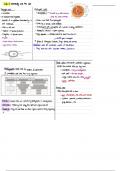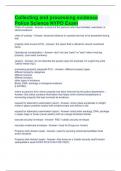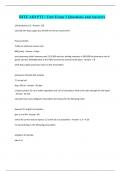Lab 1: Microscopy and the cell
Progotic
cells Eukaryotic
-
cells
-
no nucleus -yes nucleus >
-
Surrounded
by a double-membrane
membrane-band called the nuclear envelope
no
organelles
-
.
Consists of DNA than
-
a
cytoplasm surrounded by a Contain more
prokaryotes
cell membrane Divide
.
-
by a process called mitosis
mitochondria and are involved in metabolism
Have cell wall chloroplasts
-
a
energy
-
includes ribosomes
>
-
-
Capsule > provides protection
-
-
Endoplasmic reticulum -
> protein synthesis
Flagella provide Golgi apparatus > processes proteins for export fromthe cell
-
- -
> motion. -
Examples : Simplest
group of
eukaryotes
-
4 of
, pseudo bacteria ,
archaea bacteria
groups Eukayotes Protists Fungi plants and animals
-
:
, , ,
Cyano bacteria, bacteria .
Protozoa: most at unicellular ,
motile , &d heterotophic .
I
>
-
They lack sell walls. Example : amoeba
, paramecium .
:
I
Mucella autotrophicorganis
is
Endosymbiosis : States that the
ancestors of mitochondria ·
Chloroplasts - >
Carry out photosynthesis
& chloroplasts were once
free-living organisms.
· cell wall >
-
provides strength
Central vacuole > stores
·
Large -
nutrients
& water .
·
Lack Centricles
-
-
Animal
Cells :
differ from plant cells in that :
· E Chloroplasts , well walls, and vacuoles
Contains
· centriole , a nucleus , mitochondria
,
Autotrophic : produce their own nutrients by photosynthesis or
chemosynthesis .
golgi apparatus ,
ER .
Heterotrophic :
Obtaining their energy from performed organic molecules
Saprophytic :
They live and feed on dead
organic
material ,
thereby degrading
it .
, Lab 2 : Properties of
Biological membranes : Osmosis/Diffusion
All cells , both
prokaryotic and
Eukaryotic are
by a cell membrane. Called
surrounded the plasma membrane
·
·
Biological membrance are composed of : lipids carbohydrates & proteins
, ,
.
X
Phospholipids : -
phospholipids form a
bilage that provide a barrier and backbone
for the membrane which prevents many substances from entering the cell.
Proteins inserted into the phospholipid of the functions of membranes
·
bilayer cary out many
Functions of membranes
1) Barrier : - cell membrane functions as a barrier between the cell & the environment .
The lipid
bilayer blocks
entry into the cell of most substances
except water glycerol and small
-
, ,
lipid-soluble molecules·
2) from the side of the membrane where found
Transport : -
Molecules more
they are in
higher concentration to the side
of the membrane where
they are found in lower concentration - This diffusion of substances does
-
Osmosis : The diffusion of water across a
selectively not require energy so it's a passive
permeable membrane
. process.
substances like ions and molecules that cannot move
polar directly across the phospholipid bilayer
-
of cells with the help of membrane proteins inserted If substances
more in and out in the bilayer
.
more
through a protein channel or carrier down their concentration gradients (high > low) no .
energy required
-
,
↳ This is called facilitated diffusion
membrane proteins may also be involved in
moving
substances
against their concentration gradient
-
(low +high) - called active transport
3) processes (such as respiration and photosynthesis) consist of
Organization Biological
:
many steps
.
a framework carried out
Membranes provide for
organizing enzymes and electron carriers so that these processes are
in an efficient manner.
,4) Communication :
-
Communication is important so that different cells can coordinate their activities.
Hormones are molecules
synthesized by plants and animals in
responseto a stimulus.
↳ bind to receptors ,
and when that happens they activate chemical reactions in the cell .
Cell surfaces also contain receptors for :
Growth Factors :
regulate cell growth
Mitogens regulate
: cell division
5) Recognition the surfaces of the cell allows them to
recognize other cells
: molecules on
of the same
type .
also allow the to
distinguish between its own cells and those "foreign" to .
-
it
organism
Diffusion
-
important because it's when water, glyce ,
and small lipid-soluble molecules
enter the cell.
of molecules from
movent
ihe concentration >
-
-
, ~
Chapter C : The Chemical context of life
Underlying Principles
1) Life takes
place based on chemical and physical principles
> most abundant blc of
-
water
2) Form determines function
many
of the molecules 5
/
within our bodies are
3) transform
Living systems energy and matter
organic molecules which
carbon
means they are
4) information.
Living systems depend on
containing
,
High
abundance
An element's the structure of for proteins
properties depend on
it's atoms
can't explicity state the location but we
* ,
know it's in this area .
· An atom is the smallest unit
of matter
↓
.
↳ composed of subatomic particles :
-
protons , neutrons electrons
,
atom has I electron for each poton
·
Typically ,
an .
(yields an
electrically neutral atim)
↳
measured in Daltons
Isotopes
-
elements that exist in multiple forms ; differ in # of neutrons
Radiometric
· .
Dating
Similar chemical but different
properties they can have
Some radioisotopes &
·
, · are more unstable than others
Physical properties
with
higher unstability > faster -
rate of decay.
Some isotopes may be
very unstable , and that behavior "parent" decays into its
·
can · A isotope daughter isotope at
of time
of amount
affect how it behaves over a period time.
a fixed rate , expressed as the half-life .
- It takes for
12 of atom to
C-14 8 neutrons , often used for carbon decay -
Unstable radioisotopes give off energy in the form of contains
· ·
,
radiation.
dating .
Radioactive Tracers · Radiometric dating : Scientists measure the different types of
-
shows us a Clinical application isotopes and then calculate how half-lives have
many
·
for a radioisotope .
·
Depicting elevated levels of a
passed since the fossil or rock was .
formed
radioactively labeled glucose
.(sugar)
->
utilized in our body
&
for metabolism
.
Can utilize radioactive
· tracers with
Sophisticated instruments like here
,.
Radiation mutations,
· can
damage living cells , can
generate
and at high enough dosages it can lead to cell death
.
, the Potential
< highertheenert any
,
levels of electrons
Energy
· Orbitals have an impact on the geometry
of an atom
.
the
·
Energy is
capacity to cause change
it's
·
Potential Energy :
Energy that matter has based on
location and structure.
·
Chemical behavior of an atom is determined
by the distribution of
electrons within their electron shells.
We care
· about the valence electrons >elections found in the outer
-
behavior most shell
Chemical -
furthest from nucleus
determined by away
-
v E
highest energy level.
.
.
-
Elements that have a complete valence shell are
chemically inert
.
·
·
Anything else will want to complete their
↑(8e in last Shell)
last shell iner tote To
be
meansve
.
·
Atoms with valence electors can share/transfer electors wh
other atoms
· These attractions >
-
Chemical bonds
·
The formation and function of molecules depend on Chemical
bonding between atoms
.
Octet rule : process of
IP
1E 1E reaching
10
,
completion of
,
valence shell .
↓
stronger than
- single bond .
-
needs more
energy to
break
E






